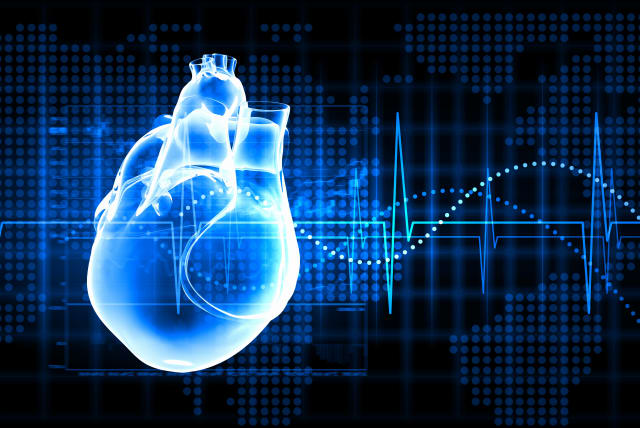This test can prevent a heart attack by catching symptoms early

A virtual catheterization (CT scan for the heart) test assesses the risk of a heart attack event in the next 10 years. It only takes a few minutes.
Mortality from heart attacks (myocardial infarction) in Israel is one of the lowest in the world standing at just 4% of deaths per month. However, the rate of complications after a heart attack is far from negligible.
What makes this even more complicated is the fact that some people who experience heart attacks don't have any early warning signs.
"The classic examples are the runner or biker who suddenly collapses in the street," said radiologist Prof. Natan Peled.
"In the world of cardiology, we try different methods to deal with this phenomenon, such as stratifying risks among the general population. One method to do this is to calculate a patient's risk of a cardiac episode by factoring in risk factors, such as age, gender, family history, excess blood lipids, hypertension, diabetes, and smoking. Among those patients, the first step is an optimal balance of these risk factors and combining clinical information with an imaging test. This demonstrates how much calcium has accumulated on the surface of the coronary arteries. This can be used to assess the risk of a heart attack in the next 10 years. This is a simple CT test that doesn't require the use of contrast and involves only very small exposure to radiation. The lack of calcification on the surface of the heart's arteries makes the chance of a heart attack in the next 10 years almost zero.
"On the other hand, if calcium is spotted on the surface of the arteries, especially in patients at a young age, it will require further treatment. The presence of sclerosis in other blood vessels throughout the body, such as the ones that supply blood to the brain and legs, only increases this risk further."
Virtual catheterization (CT scan of the heart): A test that lasts just a few minutes
In the last two decades, there have been a number of far-reaching developments in both CT scans and the field of computers as a whole. Combining advanced technologies has made it possible to examine the heart very quickly and to examine the heart's blood vessels at a very high resolution.
One of the most advanced tests to have come into use in recent years is a CT test for the heart, also known as virtual catheterization.
This test is non-invasive and doesn't require inserting a catheter into the heart like it normally would. It also still allows for optimal examination of the heart, especially on the coronary arteries, and can identify morbid sclerotic changes even at the earliest stages, before there would be any permanent damage to the heart muscle.
This test is done by using computerized tomography to carry out a detailed and precise scan of the body at high speeds, allowing for the examination of various different organs, including 3D visualizations.
"If I try to image the heart while it's still moving, the result will be blurry. Therefore, we sample the image and carry it out precisely in a very short time frame – a few hundredths of a second. This way, we get an image without any blurring, so I can see the blood vessels. We can also see what the heart looks like – the muscles and the coronary arteries inside and out," Peled explained.
"This is a very simple test and doesn't require any special preparation. The patient only needs to lie on a bed for less than a minute. The scanner then easily detects any signs of coronary sclerosis and rates it as either normal, light, moderate, or severe.
"After the test, you can go back to your everyday routine life. The diagnosis is carried out within 48 hours and – or immediately in urgent cases. The results are emailed to the patient. If further tests or treatment is necessary, they will be referred to a cardiologist and will be able to consult with the cardiologist who carried out the test."
When should you undergo a CT scan of your heart?
"Most patients are referred by their primary physician or a cardiologist at their health insurance when they suffer from angina pectoris and it isn't clear if it is a cardiac issue," Peled said.
"In these cases, the test is included in the health services basket. If you decide to do it without a doctor's referral, it will cost NIS 2,600 and you'll need to do a blood test beforehand to check kidney function."
According to Peled, men come for these tests more often than women and do so at earlier stages.
"The problem with women is that the symptoms they describe aren't as typical of heart disease, which causes them to get tested later," Peled said. "This increases their risk of heart attacks because they don't have distinct preliminary symptoms."
Jerusalem Post Store
`; document.getElementById("linkPremium").innerHTML = cont; var divWithLink = document.getElementById("premium-link"); if (divWithLink !== null && divWithLink !== 'undefined') { divWithLink.style.border = "solid 1px #cb0f3e"; divWithLink.style.textAlign = "center"; divWithLink.style.marginBottom = "15px"; divWithLink.style.marginTop = "15px"; divWithLink.style.width = "100%"; divWithLink.style.backgroundColor = "#122952"; divWithLink.style.color = "#ffffff"; divWithLink.style.lineHeight = "1.5"; } } (function (v, i) { });

